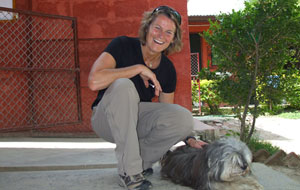Kathmandu calling for Lesley

Earlier this year, dog enthusiast and Bay of Plenty Polytechnic tutor Lesley Mochan volunteered at an animal rescue centre in Kathmandu. This is her story of an ordinary day at an extraordinary place.
It’s early morning and still reasonably cool when I arrive at the Kathmandu Animal Treatment Centre (KAT) to see for myself where the funds I've been raising from generous New Zealanders are spent.
The centre's main purpose is to implement an Animal Birth Control (ABC) programme, which includes spaying and vaccinating female dogs. They also treat diseased or injured dogs and cats. Staff are also involved in community education on disease risk (rabies) and encouraging compassion and responsibility towards the dogs that share their surroundings.
A group of resident dogs come over to meet me; my heart melts when a puppy with bandy legs gives me a lick. I walk slowly past the 18 sponsor kennels that house the pre- and post-vaccinated and sterilised dogs pausing at each kennel; some dogs wag their tails, while others eye me with distrust.
In the isolation area I meet five dogs with varying degrees of skin disorders. One dog has no hair at all, while another has a huge sore after having boiling water poured over his back.
The desexing operations are carried out in the purpose-built operating theatre - generally four or five female dogs treated each morning, after being brought into the centre after being picked up off the street the day before.
About 2pm, two of the spayed female dogs are ready to return to their communities. The spaying of these dogs will mean around four fewer litters of puppies each year.
Staff will drop them off while attending to a call-out, which is part of the rescue services the centre provides. A dog has been beaten by a group of youths and the staff will need to visit the site to determine if the dog needs KAT attention. In most cases, distress calls are carefully screened before the vehicle is sent out.
The few hours I spent at KAT took me through all levels of emotions and showed me that the staff are totally dedicated to the dogs and their wellbeing. It also confirmed my commitment to continue donating to a good cause. For more information, visit www.katcentre.org.np
